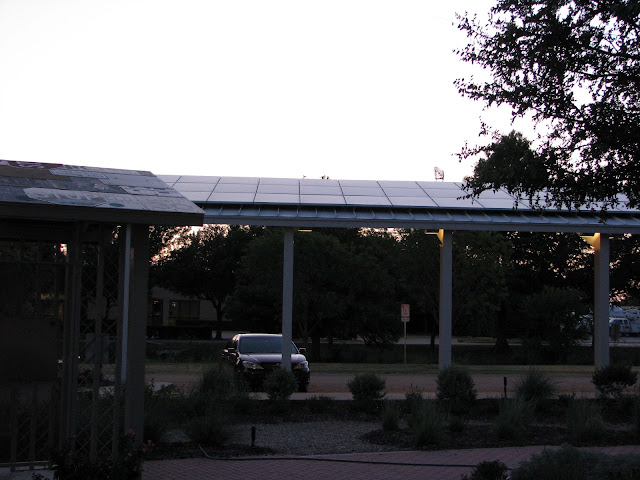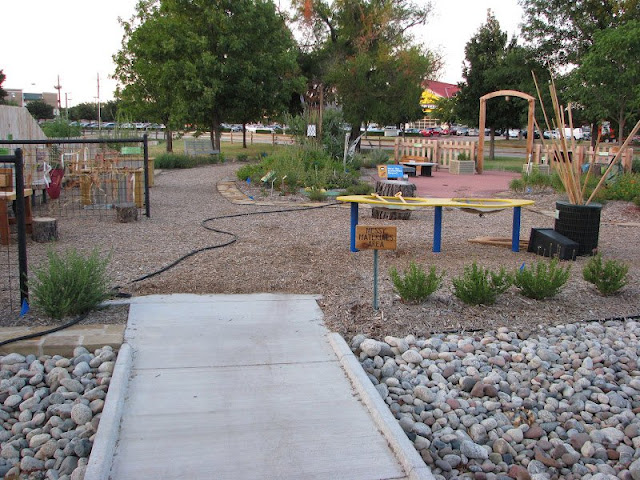
The Environmental Education Center, located at 4116 W. Plano Parkway, is a new educational facility in the city of Plano where residents of all ages can learn about sustainability and environmental stewardship. (Notice the decomposed granite parking lot.)

The EEC is the first -and only- building in Plano to receive Leadership in Energy and Environmental Design (LEED) Platinum certification.

Inside the building is a large meeting room where the city holds classes on a wide range of "green" topics. (Photo shot through a window.) Last year I attended a square foot gardening class and earlier this year I attended an energy efficiency class. Most of the programs are free, however, there may be a small fee for others. Click here for a list of upcoming programs.

While there is much to be learned inside the building, there is just as much to learn on the grounds of the EEC. For example, this 20,000 gallon cistern captures rainwater from the roof of the EEC. By touching the side of the cistern, I was able to determine that it was about half full of water. The captured rainwater is used to flush toilets in the restrooms and to irrigate the landscape. This information came from the round blue sign next to the cistern. Similar signs provide information about various features around the grounds.

This is a ground level demonstration of the living roof that tops the Center. The soil and plants help to insulate the building, which reduces energy consumption. Rainwater from the cistern is distributed on the roof top through drip irrigation.

The EEC produces 30% of its electrical needs with solar and wind power. A 60 foot wind turbine behind the building produces 3,000 kWh of power per year.

Water circulates through this thermal solar panel where it is heated by the sun and returned to a storage tank to provide hot water to the EEC. The panel is at ground level to allow visitors a close up view. Unfortunately, the panel is broken and covered with plastic. I suspect it was damaged by vandals.

Solar cells line the top of this covered walkway and parking area. The EEC's 54-panel photovoltaic array generates an estimated 17,909 kWh per year.

This open cistern collects rainwater from the walkway cover above.

Rocks and a metal cattail sculpture are inside the cistern. I think it is supposed to function as a fountain, but it is dry now.

This is the underside of the walkway cover. I believe this is reclaimed wood.

Reuse is a recurring theme at the ECC. The shingles for this passageway are made of old road signs.

Under the cover are some decorations that I believe are made with old fan blades.

More of the artwork is on the walls outside the restrooms.

You can see that this butterfly was made with an old license plate.

This kinetic sculpture, "Eco Sphere" is made with stainless steel serving ladles.

Here is a closer view. It was getting dark outside when I took this photo.

The main reason I came to the EEC on this evening was to see the new landscaping around the building. When I was last here in early February, the only plants on the grounds were a few remnants from the native plant display garden that used to be here. By February, we had received some good rains, but lakes were still pretty low in February and we were facing the possibility of Stage 4 watering restrictions. Landscaping plans for the EEC were on hold since it was not known if there would be sufficient water for the plants.The city did not want to landscape the site with that possibility looming. Fortunately, the rain kept falling and watering restrictions were relaxed. And so the gardens were planted this spring.

A sign welcomes visitors to the garden. Unfortunately, there were not any signs identifying the plants in the garden. I hope the city plans to add some. There were a couple of plants that I thought I recognized, but I was not 100% certain of the ID. Visitors would benefit from knowing the names of the plants that they like so they can obtain them for their own gardens.

Here are several clumps of little bluestem. These plants look considerably better than mine do this year.

Most of the pathways and even the parking area are composed of permeable materials, such as mulch, decomposed granite, and concrete pavers, to allow rainwater to soak into the ground rather than running off into the storm sewers.

This is a variety of Nolina. Other native plants on the grounds are rusty blackhaw viburnum, gulf muhly, sumac, cedar elm, Eve's necklace, rough leaf dogwood, palm (probably Sabal minor), agarita, lantana, big muhly, desert willow, red yucca, rock rose, Mexican buckeye, cenzio, Gregg's mistflower, and zexmenia.
The landscape also includes a few adapted non-natives like Vitex*, Russian sage*, Pennisetum fountain grass, and pink skullcap.

A planted and mulched swale runs around the EEC. I did not notice if the swale drains into a nearby creek bed or if it will hold some excess rainwater and allow it to soak into the soil.

Finally, there is a hands on educational play area that gives children several opportunities to learn about nature and sustainability.

There is a bird feeder on the other side of this bird blind to attract birds. If the children are quiet enough, they may be able to see a wild bird close up.

This butterfly garden teaches children about the butterfly life cycle, beginning with eggs laid on the leaf of a caterpillar host plant...

and ending with a butterfly ready to begin the cycle again.
There is much to be learned at the Environmental Education Center. There is a good chance that kids will come here and learn something and then go home to teach their parents a thing or two but there are plenty of educational opportunities for adults as well.
*I removed Vitex and Russian sage from my garden several years ago. These plants have appeared on invasive species lists and I was beginning to see why in my garden. On the positive side, they are both drought tolerant and attract bees.

Thanks for the photos and explanation. I'll have to go visit.
ReplyDeleteThis is a nice addition to the City of Plano, I'll have to stop by and see the gardens next time I'm up there.
ReplyDeleteI'm replacing the Russian sage in my front yard this fall. It hasn't been invasive so much as disappointing. Currently looking for the right native plant to fill in there but I would prefer blue and there aren't many that will work in the gravel garden.
Very cool...I wish we had something like this here in PDX. Love that Cattail water fountain. I would just be happy to have my Little Bluestem NOT FLOP this year!
ReplyDeleteWhat a wonderful way to help people want to change their lifestyles to ones that make all life on our planet more sustainable while living in dynamic beauty instead of a virtual and physical grass desert.
ReplyDeleteBut I hope some birders and bird photographers can help them with their blind. They need larger holes in order for people to actually be able to see the whole area. And also to allow photographers to take pictures.
And many such places work with Master Naturalists, Master Gardeners, Audubon, and gardening clubs to both design and maintain the grounds. Perhaps some of these groups could help them.
I remember reading about a Travis Audubon Sponsored garden where the group had a plant labeling workshop to make ceramic labels. While trying to find the link to that post, I found this:
http://www.greatstems.com/2010/04/making-plant-markers.html
Once you make the fields for each plant, you can format labels to print the output - Truly very easy.
And here is the link to the ceramic ones. This would also be a great way to help people in nursing homes, or students in middle or high school to have a great experience.
http://www.greatstems.com/2012/07/making-ceramic-plant-markers.html
I can imagine working with suppliers (gardening stores, places like Micheal's), artists, native plant experts, school children, Audubon, Master Naturalists, Master Gardeners to find a group or groups that would provide these markers free to the Environmental Education Center.
I was just in New Mexico where Russian sage is used extensively. I thought about putting some in but the comments make me rethink that. I do have Texas Sage and it is doing great. We cut it back fairly severely in December and every year it comes back bigger and fuller. I started with a small one from a nusery (1 gal) 3 yrs ago and it is now almost 8 ft tall and 5 ft wide.
ReplyDeleteI have a client who would like to landscape the "hell strip" in front her home. There will be no irrigation. Would you be willing to email me a list of your favorite low-growing plants (no taller than 2 feet, but preferably shorter). I would sure appreciate it. signaturegardens@verizon.net
ReplyDeleteWhat a great contribution to and example for your community...I love all the "recycled" features. Wonderful!
ReplyDeleteThat's really cool. I like to see these kinds of educational AND beautiful facilities going in. BTW, I'm posting about your eryngium today.
ReplyDeleteHola Michael. Nice post! Thank you!
ReplyDeleteI am in Richardson with a big native garden. I'll be splitting up my rattlesnake master later, and I need one more taker. Wonder if you are interested? Am looking for any monarch, if you have any to share. I also will have a million snow on the prairie seeds free for the taking soon. Shauna575 at gmail dot com
BTW. That was supposed to be monarda , not monarch. Touch screens ...gotta love them but not all the time.
Shauna, I emailed you several weeks ago. Try to get in touch with me again. Thanks.
DeleteHi Michael -
ReplyDeleteI maintain the website for Live Green in Plano (City of Plano Sustainability & Environmental Services) and we absolutley loved the pictures you took of the Environmental Education Center. Would you consider providing your pictures so I can use them on the website and in future publications? Please feel free to contact me at (972) 769-4264 or email tiffanys@plano.gov. Thank you!